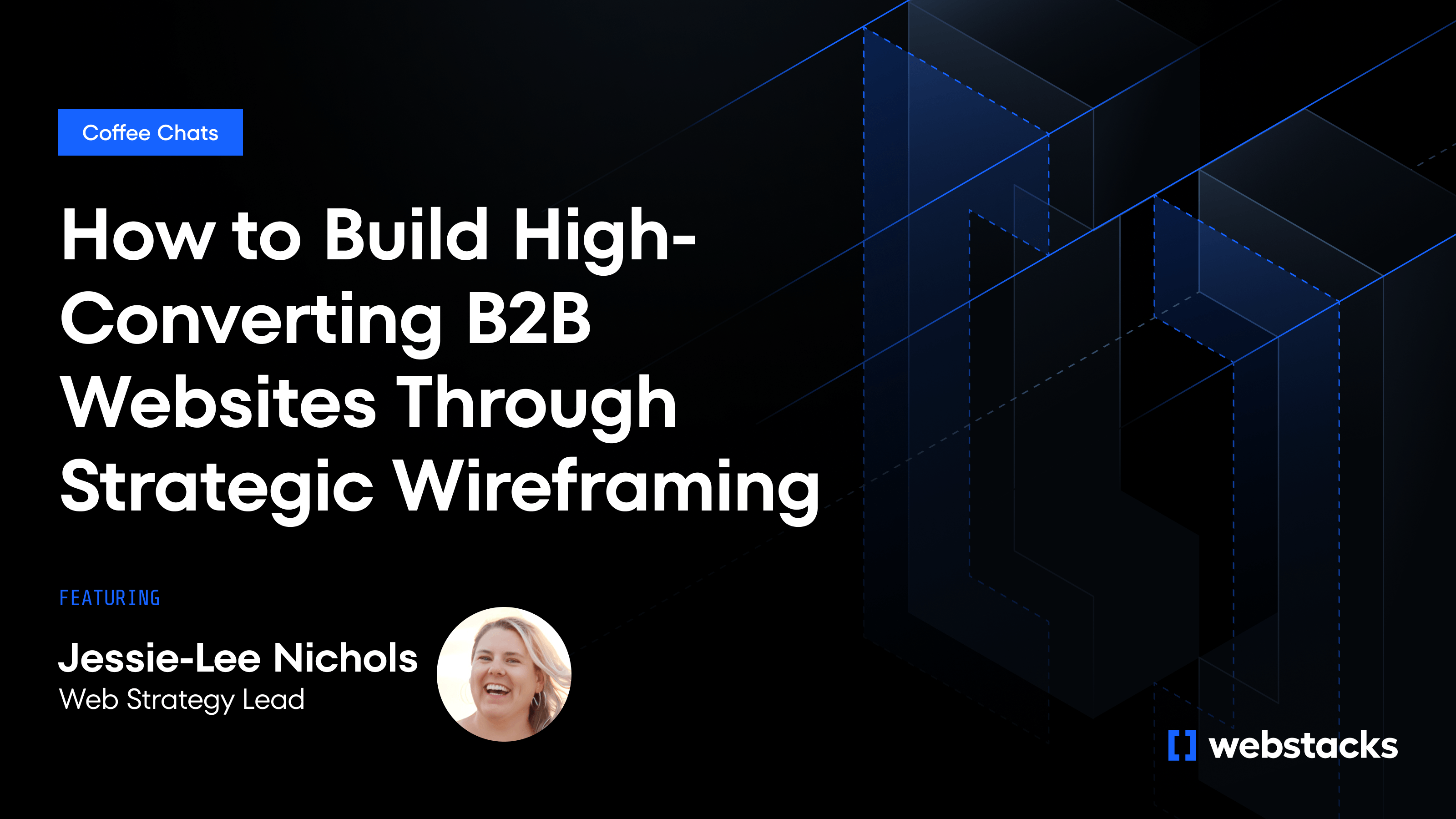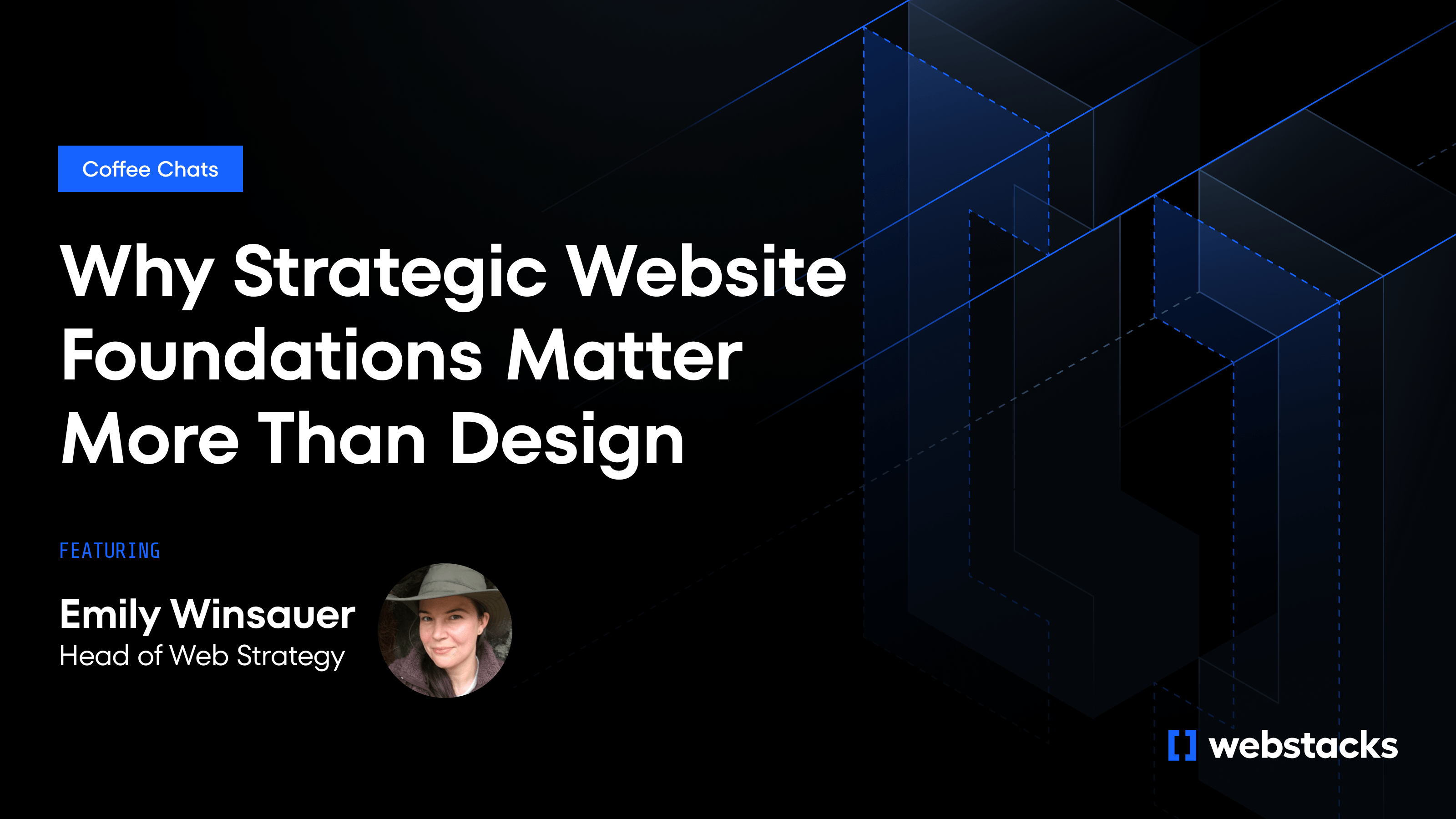Strategic wireframing transforms website projects from reactive design cycles into purposeful, conversion-focused experiences for enterprise SaaS teams.
"Even your big enterprise websites have the same problems: they're Frankenstein websites with too many cooks in the kitchen," says JL Nichols, Web Strategist at Webstacks, reflecting on a revelation from working with Gong, one of the fastest-growing SaaS platforms in the market.
Recently, I sat down with JL to explore how strategic wireframing has become the backbone of Webstacks' approach to building scalable, high-performing B2B websites. Our conversation revealed how this discipline, often misunderstood or skipped entirely, bridges the gap between business goals and executable design.
Without structured planning, website projects stall, teams clash over direction, and conversion opportunities slip away. This article distills JL's insights on why wireframing matters, how it accelerates execution, and what makes it essential for B2B SaaS companies scaling their digital presence.
Wireframing Turns Strategy Into Visual Structure
Most agencies jump straight into design mockups or content creation, leaving critical structural decisions unresolved until problems surface during QA. Wireframing solves this by defining the blueprint first.
Strategic wireframing creates visual outlines of web pages before design begins. The process defines what content appears, where it's placed, and why it matters to the user.
JL describes wireframing as the delta where web strategy, UX design, and content planning converge. Unlike traditional approaches, wireframing forces teams to answer critical questions early: What does the user need to know? In what order? What action should they take next?
"Wireframes serve a dual purpose," JL explains. "They show how the page will be laid out visually and tell you what needs to be on the page, in which place, and why."
For B2B SaaS teams, wireframes become both a planning tool and a communication artifact. Stakeholders see structure before committing to costly design iterations. Content writers receive clear direction on what to write and where. Designers gain freedom to focus on visual execution rather than wrestling with information architecture.
What Questions Wireframes Must Answer Before Design Begins
Effective wireframes resolve ambiguity by forcing answers to questions that typically surface too late in the process. Before moving to design, your wireframes should clearly answer:
For the user journey:
- What problem is the user trying to solve when they land on this page?
- What information do they need first, second, and third to feel confident taking action?
- What is the single most crucial action they should take, and where should that CTA appear?
For content requirements:
- What type of content belongs in each section (product benefit, social proof, technical spec)?
- How much copy is needed (headline only, headline plus 2-3 sentences, full paragraph)?
- What supporting assets are required (product screenshots, logos, data visualizations)?
For functionality:
- Which elements link to other pages, and what is the logical destination?
- What interactive components are needed (tabs, accordions, filters)?
- How do users navigate between related content sections?
If your wireframes leave these questions unanswered, you're pushing critical decisions into the design phase where they become exponentially more expensive to resolve.
Wireframes Align Stakeholders and Eliminate Guesswork for Enterprise Projects
Enterprise projects often stall because stakeholders struggle to visualize abstract concepts. Paint chips and written descriptions force clients to imagine outcomes, leading to misalignment and costly revisions later.
Wireframing reduces cognitive load by showing structure before design begins. Instead of interpreting abstract concepts, stakeholders see layouts that clarify functionality, hierarchy, and user flow.
"Before we introduced wireframing, clients were being shown paint chips and asked to imagine an entire vaulted ceiling living room," JL notes. "Now, we're painting an accent wall so they can actually start to see it before all the design comes together."
Analysis paralysis is a common barrier for B2B SaaS teams overhauling their websites. Without a visual reference point, stakeholders struggle to evaluate structure, prioritize content, or commit to decisions. Internal debates stretch on, blocking progress and draining momentum.
Webstacks solves this by introducing strategic wireframing early in the process. Wireframes give teams something concrete to react to—shifting conversations from abstract speculation to practical problem-solving.
FirstUp experienced this firsthand. Their team had been stalled, unable to make decisions without seeing how pages would function. Once Webstacks introduced wireframes, the project unlocked. They began asking intelligent questions about element placement and purpose, allowing Webstacks to justify every structural decision with clarity.
This pattern repeats across client engagements. Wireframes transform ambiguity into action by giving teams something concrete to react to. Conversations shift from "we're not sure what we need" to "here's what works and why." Structural alignment happens faster, design iterations decrease, and launch timelines compress.
Wireframes trigger the right questions at the right time. Functionality questions surface early: teams ask "Where does this link go?" instead of discovering gaps during QA. Expectations are set before design begins, reducing surprises and revision cycles. A shared visual language emerges across marketing, product, and leadership teams.
For enterprise clients like Gong, where multiple departments coordinate website execution, wireframes serve as the single source of truth. Point-of-contact stakeholders can confidently communicate decisions to content teams, CRO specialists, and engineering without the typical miscommunication that derails projects.
Wireframes Empower Marketers and Unblock Designers
When structural decisions aren't made up front, designers waste time wrestling with information architecture during mockups. Marketers receive vague direction, resulting in content that doesn't align with the final design. This creates a bottleneck that delays every downstream phase.
Wireframing separates structural problem-solving from visual execution. Designers receive structured blueprints that define layout, component hierarchy, and content requirements. Instead of wrestling with information architecture, they focus on visual storytelling, brand expression, and UI refinement.
"Having this level of planning allows design to be unhandcuffed," JL explains. "It allows them to be more creative because the structural pieces have been solved by somebody else in a previous phase. They're able to do UI, and it's fabulous."
For marketers, wireframes provide clear direction for content. Writers know exactly what messaging is required for each section, how much copy to write, and what tone aligns with user intent at that stage of the page.
The workflow we use at Webstacks:
- Strategy phase: Wireframes define structure, component types, and content needs
- Content phase: Writers create messaging aligned to wireframe specifications
- Design phase: Designers interpret wireframes, applying brand elements and elevating the experience
- Development phase: Engineers build based on design comps, with structure already validated
This phased approach eliminates the "building the plane while flying it" problem. Decisions are made at the right time, by the right people, with the right context.
How to Structure Content Requirements in Your Wireframes
Content bottlenecks kill project momentum. Vague direction like "write compelling copy here" forces writers to guess at length, tone, and purpose. Strong wireframes eliminate ambiguity by specifying exact content requirements for each component.
For each section in your wireframe, define four critical elements that give writers and designers clear direction.
- Content type and purpose: Specify what job this section performs in the user journey. Is this section explaining a product benefit, addressing an objection, or showcasing social proof? Without this clarity, writers default to generic messaging that fails to move users forward. For example, if a section addresses the objection that migration is complex, your wireframe should note: "This section addresses the objection that migration is complex. Content should emphasize speed and zero downtime."
- Length and format: Define the exact structure writers should follow. Does this section need a headline only? Headline plus 2-3 supporting sentences? Full paragraph with bullets? Ambiguous length requirements create mismatched content that either overwhelms the layout or leaves awkward white space. For example: "Headline (8-12 words) + supporting paragraph (3-4 sentences, 60-80 words) + 3 bullet points (each 10-15 words)."
- Tone and specificity: Clarify how technical or accessible the copy should be. Should it be product-focused or outcome-focused? This prevents the common problem where technical teams write feature-heavy copy for outcome-driven pages. For example: "Use outcome-focused language. Avoid technical jargon. Focus on time saved and reduced dependency on engineering."
- Required supporting elements: Identify what visuals, data points, or proof elements must accompany the copy. Writers can't produce complete content if they don't know whether they need customer quotes, product screenshots, or specific metrics. For example: "Include customer logo, job title, and specific metric (e.g., '30% faster content updates')."
This level of specificity transforms wireframes from structural diagrams into actionable content briefs. Writers produce better first drafts, and design receives content that fits the intended layout without endless revisions.
Enterprise Clients Face the Same Coordination Challenges as Startups
Most people assume enterprise clients have their website strategy figured out. More resources, bigger teams, dedicated departments for content and CRO. But JL’s experience with Gong revealed a surprising truth: the same structural problems exist at every company size.
"It was mind-blowing when they told me, 'We've never sat down to do a formal review of this and actually say: this is what the user needs to know, and this is why we're constructing it this way,'" JL recalls. "The same problems exist at every level. It's a matter of how you're consulting with them."
For Gong, a category-defining revenue intelligence platform, the issue wasn't a lack of resources or talent. The challenge was coordination. With dedicated departments for content, CRO, product engineering, and web development, decisions were distributed across silos. Website evolution happened ad hoc, driven by individual team initiatives rather than a cohesive strategy.
Our wireframing process gave Gong's team a structured framework to:
- Audit existing pages against user needs and business goals
- Prioritize impact by identifying which pages would deliver the most value with the least effort
- Define phased launches that balance speed with quality
The difference between enterprise and startup clients isn't the wireframing approach. It's the internal coordination required. "Your point of contact isn't necessarily the person doing the work," JL notes. "They're coordinating the work. So you have to present to them in a way that allows them to take it back to their teams."
Wireframes provide enterprise marketing leaders with the clarity and justification needed to rally cross-functional teams around execution. They become the shared reference point that keeps distributed teams aligned.
Phased Launches Work When Strategy Comes First
Large-scale website projects often require phased launches to balance ambition with execution capacity. But without a clear strategy up front, phased approaches create incomplete launches, technical debt, and misaligned priorities across releases.
Wireframing enables smarter phased planning by making trade-offs visible before development begins. When we helped Gong prioritize their roadmap, wireframes translated analytics insights into a structured execution plan. "Part of what we're doing in strategy is helping them determine, based on their analytics and what we see in the numbers: these three pages are going to give you 80% of the impact with 20% of the effort," JL explains.
- Phase 1 focused on high-visibility, high-impact pages: homepage, platform overview, and key product pages. Wireframes documented which components would be built first, establishing a reusable foundation for later phases.
- Phase 2 addressed structured content: blogs, glossaries, and resource hubs. Because Phase 1 wireframes had already defined core components (navigation, CTAs, content modules), Phase 2 teams could assemble pages faster without redesigning foundational elements.
This prioritization was only possible because wireframes provided a complete structural view of the site. Teams could evaluate effort, dependencies, and component reuse across phases. Gong's internal teams gained clarity on what to tackle first and why, with wireframes serving as the blueprint that connected strategy to execution.
Phased launches work when data and user needs guide them, not arbitrary timelines or stakeholder preferences. Wireframing ensures every phase delivers measurable value while building toward a cohesive whole.
How to Prioritize Pages for Phased Launches Using Analytics
Phased launches fail when prioritization is driven by stakeholder preferences rather than user behavior and business impact. Analytics provide the objective framework for deciding what to tackle first.
- Start with traffic and conversion data. Review Google Analytics or your analytics platform to identify which pages drive the most traffic and which pages contribute most to conversions. Look for pages with high traffic but low conversion rates (optimization opportunities) or with strong conversion rates but insufficient traffic (visibility opportunities).
- Map pages to business goals. Not all traffic is equal. A blog post with 10,000 monthly visits may matter less than a product page with 1,000 visits if the product page drives pipeline. Align page priority with revenue impact, not vanity metrics.
- Assess content and technical readiness. Some pages require minimal effort to redesign because content already exists and messaging is clear. Others require a net-new content strategy, stakeholder alignment, or complex integrations. Balance impact with execution complexity.
- Create a prioritization matrix. Plot pages on two axes: business impact (traffic, conversion contribution, strategic importance) and effort required (content needs, design complexity, technical dependencies). Pages in the high-impact, low-effort quadrant become Phase 1. High-impact, high-effort pages may need to be split across phases or tackled with additional resources.
- Use wireframes to validate the phasing strategy. Once you've prioritized pages, wireframe the Phase 1 pages to identify which components will be built. This reveals opportunities for component reuse in later phases and surfaces hidden dependencies early. Teams avoid building one-off solutions in Phase 1 that can't scale into Phase 2.
This framework removes subjectivity from phased planning. Wireframes then translate prioritized pages into structured execution plans, ensuring each phase delivers measurable progress toward business goals.
Structure Matters for AI-Powered Search
AI-powered search engines like ChatGPT, Claude, and Perplexity are changing how users discover content. Unlike traditional search engines that rely heavily on keywords and backlinks, LLMs prioritize semantic understanding and content structure.
Wireframing enforces the rigid structure that makes websites discoverable in AI-driven search. JL and Emily, Webstacks' Content Strategist, share a philosophy on this shift: "Websites should be rigidly structured. You should have secondary and tertiary menu options. We're finding that with LLMs being used for search, having that very rigid structure actually helps them deliver your site as a result much quicker because it's contextual. They can understand the path."
When we wireframe pages, we define information architecture, navigation paths, and content relationships before a single design mockup is created. This early structural planning ensures clear hierarchy, semantic HTML, and logical content organization, exactly what AI models need to crawl, index, and retrieve content accurately.
Wireframes make these invisible relationships visible. They document how a homepage connects to product pages, how product pages link to case studies, and how resource hubs support SEO-driven discovery. This becomes the blueprint for building websites optimized for both traditional search engines and AI retrieval systems.
For B2B SaaS companies competing for visibility in an AI-native search landscape, being the source LLMs cite when users ask product-related questions is the new battleground. It starts with structured, strategically planned content, and that structure begins in the wireframe.
Websites Are Products That Evolve, Not Projects That End
Most companies treat their website like a campaign: build it, launch it, move on. This creates a cycle of costly redesigns every 18-24 months as the site falls out of sync with the business.
Webstacks takes a different approach. Websites are living products that evolve with the business, not one-time projects with fixed endpoints.
Wireframes establish the modular foundation that makes continuous evolution possible. By defining reusable components (like switchbacks, card decks, and form modules) during the wireframing phase, teams build a system that can grow without requiring full-scale redesigns. Marketing teams can deploy these components independently, launching new pages or testing variations without waiting for engineering support.
JL describes this mindset in the context of ServiceTitan, a long-term Webstacks client: "They embraced a culture of continuous improvement. They shared the same perspective as Webstacks: that a website is not a project, because it is never finished."
ServiceTitan's success came from the component library established during initial wireframing. As their business evolved, they could launch new product pages, expand content hubs, and optimize conversion paths by reassembling existing components in new configurations. The wireframes didn't just document what to build; they documented a system for how to keep building.
The outcome:
- Content editors gain autonomy to launch pages without waiting for engineering support
- Designers can refine UI without restructuring entire templates
- Marketing teams can test, learn, and optimize continuously
The result is a website that grows with the business, not a static asset that becomes outdated within 18 months. Wireframing makes this possible by designing for evolution from day one.
How Webstacks Delivers Scalable, Conversion-Focused Websites
The challenges JL describes (stakeholder misalignment, reactive design, and Frankenstein websites) are common in B2B SaaS. Webstacks solves them through a disciplined, strategy-first approach anchored by wireframing.
Webstacks' approach:
- Structured discovery and stakeholder interviews ensure website strategy aligns with business goals and user needs
- Component-based wireframing defines layout, hierarchy, and content requirements before design begins
- Modular design systems enable rapid iteration and empower marketing teams to operate independently
- Phased launch planning prioritizes high-impact pages and ensures measurable ROI at every stage
For enterprise clients like Gong, this approach compressed decision-making timelines, reduced design revisions, and delivered a platform capable of supporting aggressive growth. For startups, it provided the foundation to scale from MVP to market-ready in record time.
The common thread? Websites built as products, designed to convert, optimized for continuous improvement, and structured for long-term success. Talk to Webstacks today about how transform your website from a static page to a dynamic product.




